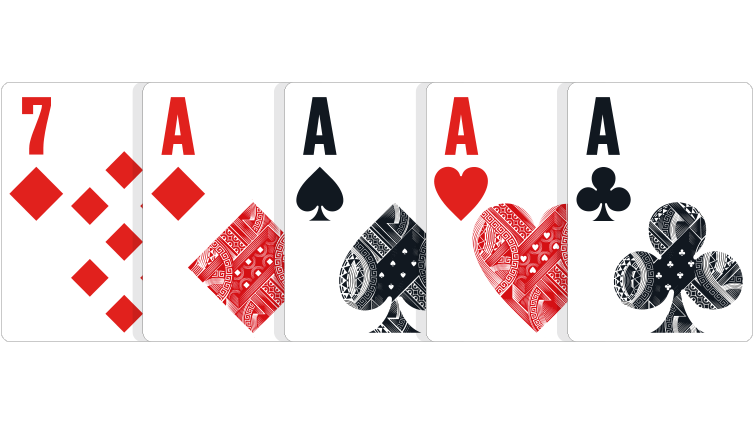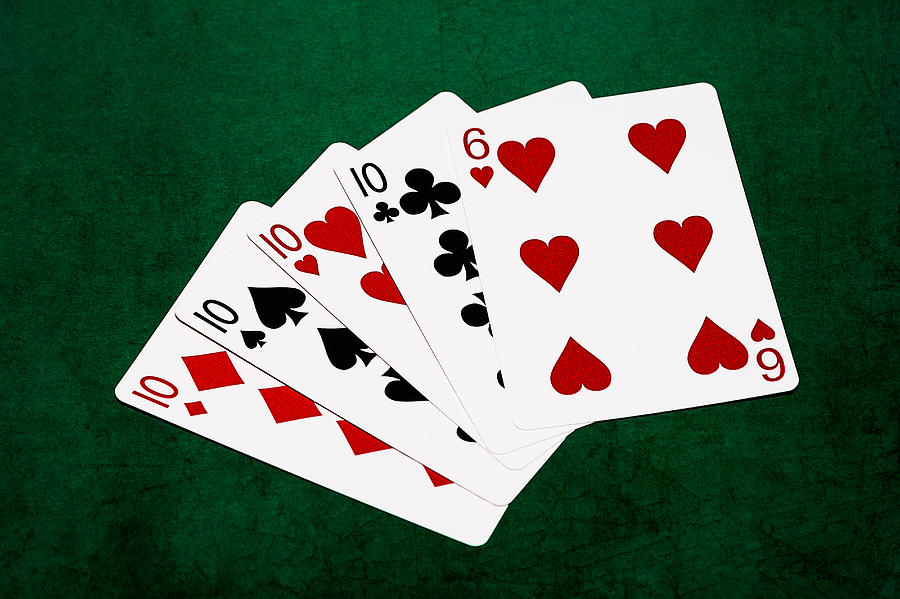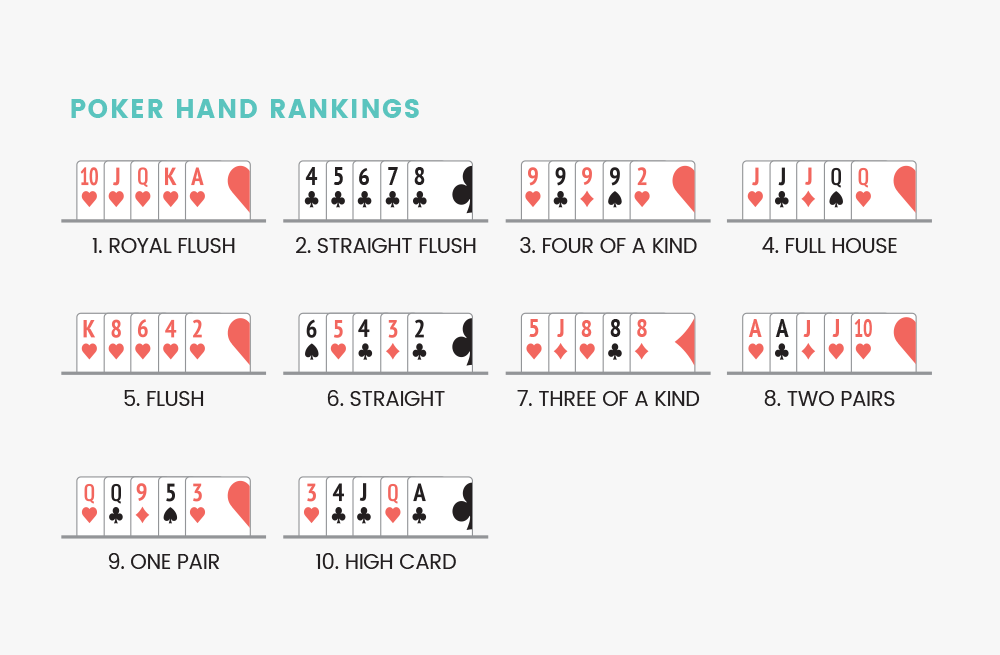Poker Hands 5 Of A Kind
Knowing what beats what in poker or Texas Hold’em is an important early step in learning the game. To help you out, I have provided for you an attractive printable or downloadable “cheat sheet” for both 5 card hand rankings as well as top 24 pre-flop starting hands. Up against another Royal Flush, you would tie. You would only encounter a 5 of a kind playing with wild cards, but the 5 of a kind would win. 5 OF A KIND: Only when playing poker with wild cards will you encounter such a hand as this, for there are normally only four of each value in each deck of cards. At any rate, this hand beats everything. Playing poker with wild cards allows 5 of a kind. A wild card can be any card. 5 Aces is the best hand. 5 of a kind beats a straight flush. Source (s): the rules of poker. Poker Hand Rankings Chart. Print out this free poker hand rankings chart – and always know the best winning poker hands. Poker hands are ranked in order from best to worst.
Every poker player knows that the Royal Flush is the strongest poker hand, but where do all of the other poker winning hands rank? Here is a comprehensive list of poker hands in order from highest to lowest ranking. If you are new to the game of poker, learning the different poker hands is a great first step in learning how to beat your opponents with the cards you are dealt.
#1 Royal Flush
The strongest poker hand is the royal flush. It consists of Ten, Jack, Queen, King, and Ace, all of the same suit, e.g. diamonds, spades, hearts, or clubs.
#2 Straight Flush
The second strongest hand in poker is the straight flush. It is composed of five consecutive cards of the same suit. If two players have a straight flush, the player with the highest cards wins.
#3 Four-of-a-kind
A four-of-a-kind is four cards of the same rank, e.g. four Aces. If two players have four-of-a-kind, then the one with the highest four-of-a-kind wins. If they have the same (if four-of-a-kind is on the board), then the player with the highest fifth card wins, since a poker hand is always composed of five cards.
#4 Full House
A full house is a combination of a three-of-a-kind and a pair. If two players have a full house, then the one with the highest three-of-a-kind wins. If they have the same one, then the pair counts.
#5 Flush
Five cards of the same suit make a flush. If two players have a flush, then the one with the highest cards wins.
#6 Straight

Five consecutive cards are called a straight. If two players have a straight, the one with the highest cards wins.
#7 Three-of-a-kind
A three-of-a-kind is composed of three cards of the same rank. If two players have the same three-of-a-kind, then the other cards, or both cards, determine the winner, since a poker hand is a always composed of five cards.
#8 Two-pair
Two-pair hands are, of course, composed of two pairs. If two players have two-pair, the rank of the higher pair determines the winner. If they have the same higher pair, then the lower one counts. If that is also the same, then the fifth card counts.
#9 Pair
A pair is composed of two cards of the same rank. Since a poker hand is always composed of five cards, the other three cards are so-called “kickers”. In case two players have the same pair, then the one with the highest kicker wins.
#10 High card
If you don’t even have a pair, then you look at the strength of your cards. If there are two players at showdown who don’t have a pair or better, then the one with the highest cards wins.
Any of the PalaPoker.com games use the standard rank of hands to determine the high hand.
However, at PalaPoker.com we also play “split pot” games, like Omaha Hi-Lo8 and Stud Hi-Lo8, in which the highest hand splits the pot with a qualifying (“8 or better”) low hand; therefore, we must also be familiar with:
Low Poker Hands List:
This method of ranking low hands is used in traditional Hi/Lo games, like Omaha Hi/Lo and Stud Hi/Lo, as well as in Razz, the ‘low only’ Stud game.
Note that suits are irrelevant for Ace to Five low. A flush or straight does not ‘break’ an Ace to Five low poker hand. Aces are always a ‘low’ card when considering a low hand.
Please also note that the value of a five-card low hand starts with the top card, and goes down from there.
#1 Five Low, or “Wheel“: The Five, Four, Three, Deuce and Ace.
In the event of a tie: All Five-high hands split the pot.
#2 Six Low: Any five unpaired cards with the highest card being a Six.
In the event of a tie: The lower second-highest ranking card wins the pot. Thus 6,4,3,2,A defeats 6,5,4,2,A. If necessary, the third-highest, fourth-highest and fifth-highest cards in the hand can be used to break the tie.
#3 Seven Low: Any five unpaired cards with the highest card being a Seven.
In the event of a tie: The lower second-highest ranking card wins the pot. If necessary, the third- highest, fourth-highest and fifth-highest cards in the hand can be used to break the tie.
#4 Eight Low: Any five unpaired cards with the highest card being an Eight.
In the event of a tie: The lower second-highest ranking card wins the pot. If necessary, the third-highest, fourth-highest and fifth-highest cards in the hand can be used to break the tie. An Eight Low is the weakest hand that qualifies for low in Omaha Hi/Lo and Stud Hi/Lo.
Poker Hands Chart With 5 Of A Kind
Check back here as you are learning the game of poker for a list that details the poker hands order. Sign up today to start winning real money!
POKER PROBABILITIES
- Texas Hold'em Poker
Texas Hold'em Poker probabilities - Omaha Poker
Omaha Poker probabilities - 5 Card Poker
5 Card Poker probabilities
POKER CALCULATOR
- Poker calculator
Poker odds calculator
POKER INFORMATION
- Poker hand rankings
Ranking of poker hands
In poker, the probability of each type of 5-card hand can be computed by calculating the proportion of hands of that type among all possible hands.

Frequency of 5-card poker hands
The following enumerates the (absolute) frequency of each hand, given all combinations of 5 cards randomly drawn from a full deck of 52 without replacement. Wild cards are not considered. The probability of drawing a given hand is calculated by dividing the number of ways of drawing the hand by the total number of 5-card hands (the sample space, five-card hands). The odds are defined as the ratio (1/p) - 1 : 1, where p is the probability. Note that the cumulative column contains the probability of being dealt that hand or any of the hands ranked higher than it. (The frequencies given are exact; the probabilities and odds are approximate.)
The nCr function on most scientific calculators can be used to calculate hand frequencies; entering nCr with 52 and 5, for example, yields as above.
| Hand | Frequency | Approx. Probability | Approx. Cumulative | Approx. Odds | Mathematical expression of absolute frequency |
|---|---|---|---|---|---|
| Royal flush | 4 | 0.000154% | 0.000154% | 649,739 : 1 | |
| Straight flush (excluding royal flush) | 36 | 0.00139% | 0.00154% | 72,192.33 : 1 | |
| Four of a kind | 624 | 0.0240% | 0.0256% | 4,164 : 1 | |
| Full house | 3,744 | 0.144% | 0.170% | 693.2 : 1 | |
| Flush (excluding royal flush and straight flush) | 5,108 | 0.197% | 0.367% | 507.8 : 1 | |
| Straight (excluding royal flush and straight flush) | 10,200 | 0.392% | 0.76% | 253.8 : 1 | |
| Three of a kind | 54,912 | 2.11% | 2.87% | 46.3 : 1 | |
| Two pair | 123,552 | 4.75% | 7.62% | 20.03 : 1 | |
| One pair | 1,098,240 | 42.3% | 49.9% | 1.36 : 1 | |
| No pair / High card | 1,302,540 | 50.1% | 100% | .995 : 1 | |
| Total | 2,598,960 | 100% | 100% | 1 : 1 |
The royal flush is a case of the straight flush. It can be formed 4 ways (one for each suit), giving it a probability of 0.000154% and odds of 649,739 : 1.
When ace-low straights and ace-low straight flushes are not counted, the probabilities of each are reduced: straights and straight flushes each become 9/10 as common as they otherwise would be. The 4 missed straight flushes become flushes and the 1,020 missed straights become no pair.
Note that since suits have no relative value in poker, two hands can be considered identical if one hand can be transformed into the other by swapping suits. For example, the hand 3♣ 7♣ 8♣ Q♠ A♠ is identical to 3♦ 7♦ 8♦ Q♥ A♥ because replacing all of the clubs in the first hand with diamonds and all of the spades with hearts produces the second hand. So eliminating identical hands that ignore relative suit values, there are only 134,459 distinct hands.
The number of distinct poker hands is even smaller. For example, 3♣ 7♣ 8♣ Q♠ A♠ and 3♦ 7♣ 8♦ Q♥ A♥ are not identical hands when just ignoring suit assignments because one hand has three suits, while the other hand has only two—that difference could affect the relative value of each hand when there are more cards to come. However, even though the hands are not identical from that perspective, they still form equivalent poker hands because each hand is an A-Q-8-7-3 high card hand. There are 7,462 distinct poker hands.

Derivation of frequencies of 5-card poker hands
of the binomial coefficients and their interpretation as the number of ways of choosing elements from a given set. See also: sample space and event (probability theory).
- Straight flush — Each straight flush is uniquely determined by its highest ranking card; and these ranks go from 5 (A-2-3-4-5) up to A (10-J-Q-K-A) in each of the 4 suits. Thus, the total number of straight flushes is:
- Royal straight flush — A royal straight flush is a subset of all straight flushes in which the ace is the highest card (ie 10-J-Q-K-A in any of the four suits). Thus, the total number of royal straight flushes is
- or simply . Note: this means that the total number of non-Royal straight flushes is 36.
- Royal straight flush — A royal straight flush is a subset of all straight flushes in which the ace is the highest card (ie 10-J-Q-K-A in any of the four suits). Thus, the total number of royal straight flushes is
- Four of a kind — Any one of the thirteen ranks can form the four of a kind by selecting all four of the suits in that rank. The final card can have any one of the twelve remaining ranks, and any suit. Thus, the total number of four-of-a-kinds is:
- Full house — The full house comprises a triple (three of a kind) and a pair. The triple can be any one of the thirteen ranks, and consists of three of the four suits. The pair can be any one of the remaining twelve ranks, and consists of two of the four suits. Thus, the total number of full houses is:
- Flush — The flush contains any five of the thirteen ranks, all of which belong to one of the four suits, minus the 40 straight flushes. Thus, the total number of flushes is:
- Straight — The straight consists of any one of the ten possible sequences of five consecutive cards, from 5-4-3-2-A to A-K-Q-J-10. Each of these five cards can have any one of the four suits. Finally, as with the flush, the 40 straight flushes must be excluded, giving:

- Three of a kind — Any of the thirteen ranks can form the three of a kind, which can contain any three of the four suits. The remaining two cards can have any two of the remaining twelve ranks, and each can have any of the four suits. Thus, the total number of three-of-a-kinds is:
Poker Hands Ranking With 5 Of A Kind
- Two pair — The pairs can have any two of the thirteen ranks, and each pair can have two of the four suits. The final card can have any one of the eleven remaining ranks, and any suit. Thus, the total number of two-pairs is:
- Pair — The pair can have any one of the thirteen ranks, and any two of the four suits. The remaining three cards can have any three of the remaining twelve ranks, and each can have any of the four suits. Thus, the total number of pair hands is:
- No pair — A no-pair hand contains five of the thirteen ranks, discounting the ten possible straights, and each card can have any of the four suits, discounting the four possible flushes. Alternatively, a no-pair hand is any hand that does not fall into one of the above categories; that is, any way to choose five out of 52 cards, discounting all of the above hands. Thus, the total number of no-pair hands is:
- Any five card poker hand — The total number of five card hands that can be drawn from a deck of cards is found using a combination selecting five cards, in any order where n refers to the number of items that can be selected and r to the sample size; the '!' is the factorial operator:
This guide is licensed under the GNU Free Documentation License. It uses material from the Wikipedia.
Home > 5 Card Poker probabilities